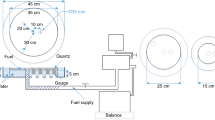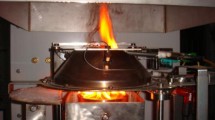Abstract
Aqueous foams are generally thought to suppress pool fires by forming a transport barrier (either an aqueous film or the foam itself) that prevents fuel vapor transport from the hot pool surface into the fire above. The present work is aimed at evaluating a different potential suppression mechanism wherein the fuel vapor pressure is reduced due to pool surface cooling that occurs when a room-temperature foam is brought in direct contact with the hot pool surface. We present a model to predict the sudden decrease in pool surface temperature when aqueous foam is applied instantaneously and uniformly onto a shallow, burning, heptane fuel pool. Conduction is assumed to dominate heat transfer at short time scales (a few seconds) due to the steep temperature gradient at the interface. The model describes the time evolution of the temperature profile by numerically solving a transient, one-dimensional, heat-conduction equation in the liquid pool and in the foam layer. We also obtained an analytical solution that is valid immediately after contact between fuel and foam. Model predictions show a significant decrease in fuel surface temperature in less than a second after the foam layer is placed on top of a hot liquid pool surface, causing a decrease in the fuel vapor pressure of over 75%. The predictions indicate that surface cooling could be an important mechanism of fire suppression by aqueous foams.











Similar content being viewed by others
References
Moody CA, Field JA (2000) Perfluorinated surfactants and the environmental implications of their use on fire-fighting foams. Environ Sci Technol 34:3684–3870. doi:10.1021/es991359u
Williams BA, Murray T, Butterworth C, Burger Z, Sheinson RS, Fleming JW, Whitehurst C, Farley JP (2011) Extinguishment and Burnback tests of fluorinated and fluorine-free firefighting foams with and without film formation. Paper presented at the suppression, detection, and signaling research and applications (SUPDET) 2011, Orlando, FL, 22–25 March
Schaefer TH, Dlugogorski BZ, Kennedy EM (2008) Sealability properties of fluorine-free fire-fighting foams (FfreeF). Fire Technol 44(3):297–309. doi:10.1007/s10694-007-0030-8
Novozhilov V, Harvie DJE, Kent JH, Apte VB, Pearson D (1997) A computational fluid dynamics study of wood fire extinguishment by water sprinkler. Fire Saf J 29(4):259–282. doi:10.1016/S0379-7112(97)00027-1
Ndubizu CC, Ananth R, Tatem PA (2000) The effects of droplet size and injection orientation on water mist suppression of low and high boiling point liquid pool fires. Combust Sci Technol 157:63-86. doi:10.1080/00102200008947310
Lattimer BY, Hanauska CP, Scheffey JL, Williams FW (2003) The use of small-scale test data to characterize some aspects of fire fighting foam for suppression modeling. Fire Saf J 38(2):117–146. doi:10.1016/S0379-7112(02)00054-1
Boyd CF, Di Marzo M (1998) The behavior of a fire-protection foam exposed to radiant heating. Int J Heat Mass Trans 41(12):1719–1728. doi:10.1016/S0017-9310(97)00280-9
Chen B, Lu SX, Li CH, Kang QS, Yuan M (2012) Unsteady burning of thin-layer pool fires. J Fire Sci 30(1):3–15. doi:10.1177/0734904111415807
Magrabi SA, Dlugogorski BZ, Jameson GJ (2001) Free drainage in aqueous foams: model and experimental study. Aiche J 47(2):314–327. doi:10.1002/aic.690470210
Magrabi SA, Dlugogorski BZ, Jameson GJ (1999) Bubble size distribution and coarsening of aqueous foams. Chem Eng Sci 54(18):4007–4022. doi:10.1016/S0009-2509(99)00098-6
Magrabi SA, Dlugogorski BZ, Jameson GJ (2000) The performance of aged aqueous foams for mitigation of thermal radiation. Dev Chem Eng Miner Process 8:93–112
DOD (1994) MIL-F-24385F (SH). Fire extinguishing agent, aqueous film forming foam (AFFF) liquid concentrate, for fresh and seawater
Ananth R, Farley JP (2010) Suppression dynamics of a co-flow diffusion flame with high expansion aqueous foam. J Fire Sci 28 (2):181–208. doi:10.1177/0734904109341030
Deen WM (2012) Analysis of transport phenomena. 2nd edn. Oxford University Press, New York
Williamham CB, Taylor WJ, Pignocco JM, Rossini FD (1945) Vapor pressures and boiling points of some paraffin, alkylcyclopentane, alkylcyclohexane, and alkylbenzene hydrocarbons. J Res Natl Bur Stand (US) 35:219–244
Incropera FP, DeWitt DP (2000) Fundamentals of heat and mass transfer. 4th edn. Wiley, New York
Acknowledgements
We thank Office of Naval Research Laboratory for their support during this work. We also thank Dr. James W. Fleming for numerous discussions.
Author information
Authors and Affiliations
Corresponding author
Appendix: Analytical Solution for Surface Cooling
Appendix: Analytical Solution for Surface Cooling
We derive below an analytical solution for heat transfer between the fuel and foam, as described in Sect. 2.2. The key advantage of the solution is that it involves an interface with zero thickness, which is more realistic than the interface of finite thickness used as an approximation in the numerical model.
The idealized problem includes two semi-infinite layers (fuel and foam), both with uniform initial temperatures that are brought into direct contact at t = 0 (see Figure 4 of the main paper); we solve the unsteady heat conduction equations in the two layers. The interface between the materials is at x = 0. The fuel layer corresponds to x < 0, and the foam layer corresponds to x > 0. We use subscripts 1 and 2 to denote the properties of the fuel and foam layers, respectively. The initial temperatures are T 1(t = 0) = T 01 and T 2(t = 0) = T 02 , respectively, and T 01 > T 02 . The thermal properties k, ρ, and c are different in the two layers. We solve for the temperatures in each layer (T 1 and T 2) as functions of time, with particular interest on the interface temperature.
The heat conduction equation for each layer is
where i is an index for the layers (i = 1, 2), α i is the thermal diffusivity (k i /(ρ i c i )), and Θ i is the non-dimensionalized temperature, given by
The conduction equation requires one initial condition and two boundary conditions for each layer. The initial conditions correspond to uniform temperatures T 01 and T 02 in layers 1 (fuel) and 2 (foam), respectively:
Very far from the interface, the temperatures remain at the initial temperatures, corresponding to the boundary conditions
The heat flux entering the interface from layer 1 (fuel) is equal to the flux exiting the interface into layer 2 (foam), corresponding to the boundary condition
Upon contact, the temperature becomes continuous at the interface, corresponding to the boundary condition
The similarity method (e.g., [14] ) is used to obtain an analytical solution for the problem. The relationship between the physical heat conduction length scale and time scale are used to define a similarity variable as
Using the similarity variable, the heat conduction equation that depends on x and t (Eq. 14) is reduced to an ordinary differential equation that depends only on η and is given by
The solution to Eq. (23) is given by [14]
where ϕ i1 and ϕ i2 are constants determined by the boundary conditions. Two “boundary” conditions for η in each layer are needed to solve for the constants, which are determined below.
Using the similarity variable, the initial condition in Eq. (16) and boundary condition in Eq. (18) can be included in a single boundary condition
Similarly, in layer 2 (foam), Eqs. (17) and (19) correspond to
The heat flux boundary condition at the interface in Eq. (20) corresponds to
The continuous temperature at the interface (Eq. 21) corresponds to
Equations (25)–(28) are used to solve for the constants ϕ i1 and ϕ i2 in Eq. (24), which gives
The solutions for Θ 1 and Θ 2 are given by
The interface temperature corresponds to η 1 = 0 in Eq. (30) (or, equivalently, η 2 = 0 in Eq. 31), given by
This analysis shows that the interface temperature decreases instantaneously when the foam layer makes direct contact with the pool surface and thermal equilibrium is established at the interface. The interface cools because the two layers are at different temperatures, and the cooling by conduction occurs instantaneously because the interface has no volume and no thermal mass. The cooling of liquid fuel underneath the interface does take time and depends on the rate of heat absorption by the foam, as described in the main body of the paper.
Rights and permissions
About this article
Cite this article
Conroy, M.W., Ananth, R. Fuel Surface Cooling by Aqueous Foam: A Pool Fire Suppression Mechanism. Fire Technol 51, 667–689 (2015). https://doi.org/10.1007/s10694-015-0470-5
Received:
Accepted:
Published:
Issue Date:
DOI: https://doi.org/10.1007/s10694-015-0470-5




